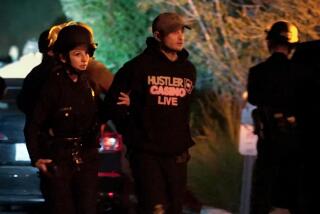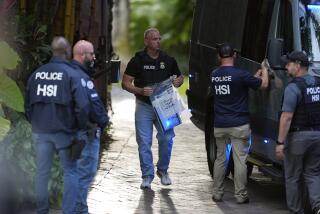Sam Giancana’s daughter aims to cash in on gangster’s memorabilia
He was one of Sin City’s original gangsters, an international crime boss who liked to brag that he owned Las Vegas, and an unapologetic irritant of Atty. Gen. Robert F. Kennedy.
Sam Giancana has been dead for decades -- shot execution-style in 1975 as he prepared a midnight snack of sausages and spinach in the basement of his Chicago-area home. But many of his prized possessions are still around -- and some are being sold Saturday in Las Vegas.
Organizers say the estate auction features a significant Mafia antique collection of a crime figure once characterized as a “tough, swaggering, flamboyant murderer.”
Available for bidding both online and at the Gambler’s General Store in downtown Las Vegas are never-before-seen photographs, including a rare snapshot with Frank Sinatra, court transcripts, arrest reports, the coroner’s report and such personal mementos as monogrammed silverware and wine glasses.
Each item includes a certificate of authenticity, signed and verified by his surviving daughter, Antoinette Giancana, said Geno Munari, owner of Munari Auctions.
“He was the most outrageous gangster of all time – the FBI followed him everywhere,” Munari said. “Many say he was under contract to help the CIA kill Fidel Castro. He was also a guy who wrote beautiful cards to his wife. The auction features the good and the bad of a notorious crime boss.”
Born Momo Salvatore Giancana, he rose to become a powerful chief of the Chicago crime syndicate in 1955, taking over the daily operations from the aging Anthony “Big Tuna” Accardo. Both Giancana and Accardo worked in the old Al Capone gang of the 1920s and ‘30s.
Tony Montana, a Las Vegas resident who once served on Giancana’s staff, said Capone had no choice but to incorporate Giancana after he helped start a rival Chicago syndicate called the 42 Gang.
“He was into some things with a bunch of guys, including Milwaukee Phil and the English brothers, and they were robbing and shaking down so many joints that Capone took notice of them,” he said. “They were young and he figured he’d better bring them on board.”
Giancana soon became the new face of U.S. organized crime, leading the criminal infiltration of labor unions, gambling casinos and legitimate businesses, relying more on corrupt politicians and police than on his own thugs.
Early on, Giancana developed a reputation as a killer. During World War II the draft board labeled him “a constitutional psychopath with an inadequate personality.” In a military interview, when asked what he did for a living, Giancana matter-of-factly replied, “I steal.”
Officials sent him home as unfit for service. And they didn’t know half of it, unaware of the illegal mayhem Giancana would eventually inflict.
Years later, in Las Vegas, he bragged about rubbing elbows with Frank Sinatra and the Rat Pack as he ran various casinos. He once told an FBI agent: “I own Chicago. I own Miami. I own Las Vegas.”
Michael Green, a historian at UNLV, said Giancana’s power in Sin City was shadowy but very real. “As Woody Allen once said, ‘Organized crime figures saved a lot of money on office space.’”
Giancana was one of the first inductees into the so-called Black Book, a list of undesirables compiled by the Nevada Gambling Commission, and he had an invisible hand in running “almost certainly the Riviera and possibly the Sands,” Green said.
His criminal career included a shadowy relationship with the CIA. In exchange for his help organizing a plot to kill Castro, experts say, agents tapped the hotel room of comedian Dan Rowan, who Giancana suspected was interested in his then-girlfriend, Phyllis McGuire -- the youngest member of the McGuire Sisters -- whom he met in Las Vegas in 1960.
Montana said his job for Giancana was to help set up new bars and restaurants. “He had to make money somewhere legitimately and he couldn’t legally get a liquor license,” he said.
Giancana lived most of his final years in Mexico, on the lam from federal authorities, but was deported back to the U.S. in 1974. Within a year, he was dead. As federal authorities pressured him to open up to a newly formed grand jury, the aging mob boss was shot six times at close range late one night, before he got to enjoy his midnight snack – his end as violent as his life.
Dressed in a sports shirt and slacks, he was found lying face-up in a puddle of blood. His wife was on the second floor of the fortress-like home in Oak Park, and told police she heard nothing.
Experts say mob figures believed Giancana, 67, was planning to talk to federal authorities about their activities. He was set to appear before a Senate committee in Washington a few days later.
Montana said the items for auction on Saturday include several valuable photos, including one of the capo on the beach, accompanied by bodyguards including Murray “The Camel” Humphries.
Montana then launched into a brief history of which figures “got whacked” and why, including a list of their crimes.
“We all committed crimes,” he said. “If we didn’t, we wouldn’t have anything to talk about.”
Twitter: @jglionna
More to Read
Start your day right
Sign up for Essential California for news, features and recommendations from the L.A. Times and beyond in your inbox six days a week.
You may occasionally receive promotional content from the Los Angeles Times.







